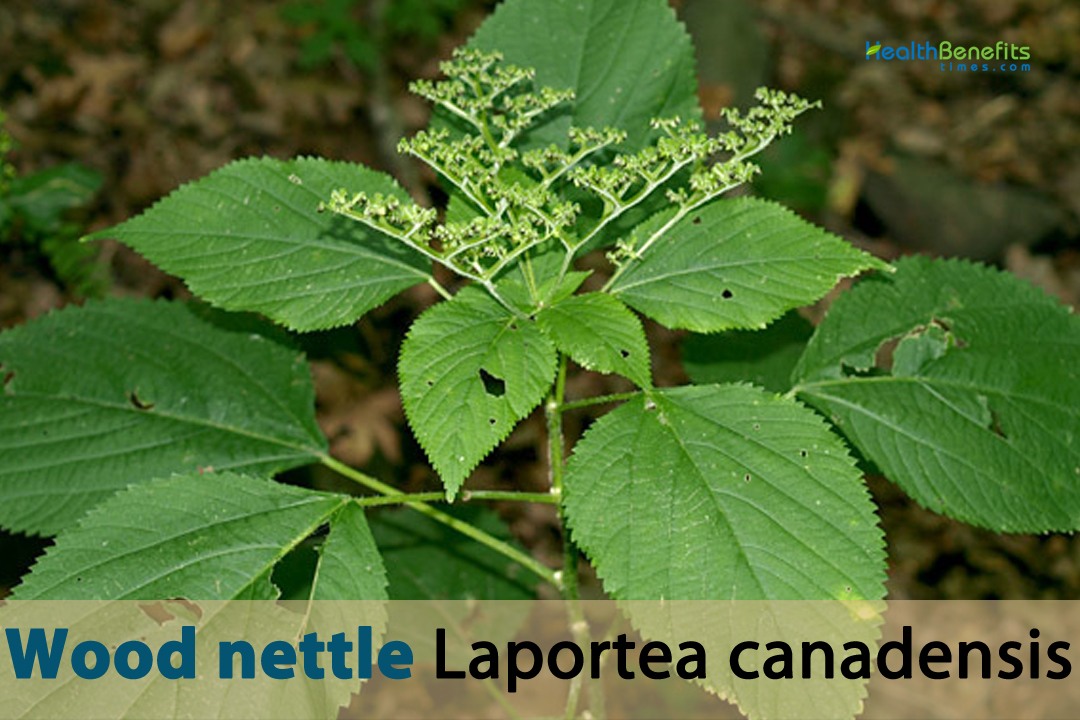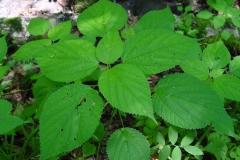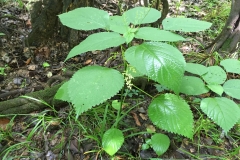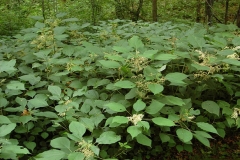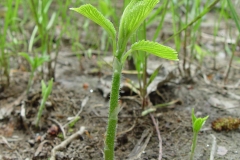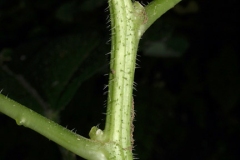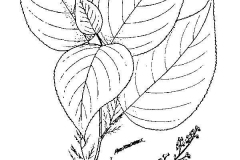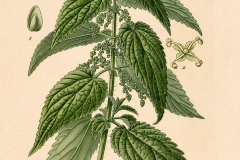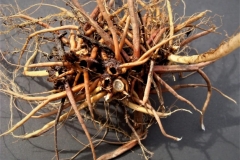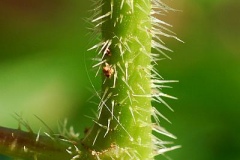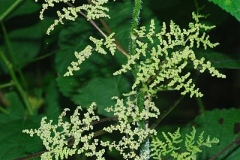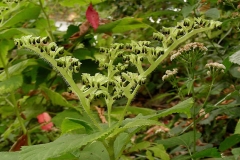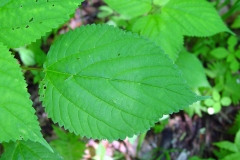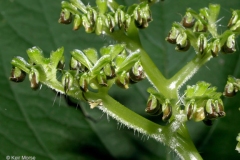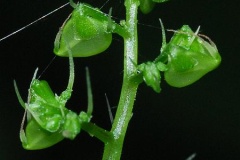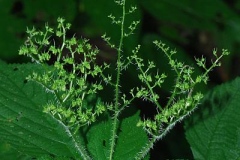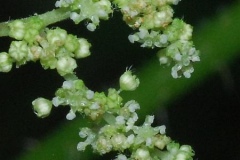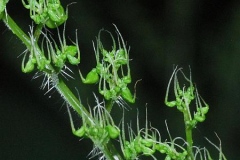This genus name, “Laportea,” honors the French botanist François Léonard Laporte, who lived during the 18th and 19th centuries. He made contributions to the field of entomology (the study of insects) and was also interested in natural history. The specific epithet “canadensis” refers to Canada, the country in North America. This part of the name signifies the plant’s geographic origin or association with Canada. It is harvested from the wild for local use as a food, medicine and source of materials. It can be incorporated into culinary creations. With a taste profile similar to spinach, it can be used in soups, stews, and even teas, providing a unique and nutritious twist to familiar dishes.
Wood Nettle Facts
| Wood nettle Quick Facts | |
|---|---|
| Name: | Wood nettle |
| Scientific Name: | Laportea canadensis |
| Origin | In U.S., the species occurs from Louisiana to Oklahoma to North Dakota and thence across the country to the Atlantic and Gulf coasts |
| Shapes | Small dry fruit that is curved and ovoid in shape |
| Taste | Mild, slightly bitter, and slightly tangy |
| Major nutrients | • Vitamin • Minerals • Protein • Dietary Fiber • Phytonutrients • Omega-3 Fatty Acids |
| Health benefits | Pain Relief, Joint Health, Skin Health, Urinary Tract Health, Allergy Relief, Digestive Support, Bone Health, Blood Sugar Regulation, Cardiovascular Health, Hormonal Balance, Respiratory Health, Liver Health, Wound Healing, Hair and Scalp Health |
| Name | Wood nettle |
|---|---|
| Scientific Name | Laportea canadensis |
| Native | In U.S., the species occurs from Louisiana to Oklahoma to North Dakota and thence across the country to the Atlantic and Gulf coasts. In Arkansas, it occurs statewide except for portions of the Mississippi Alluvial and West Gulf Coastal Plains |
| Common Names | Smooth nettle, Wood nettle, Canadian woodnettle, Tall nettle, Stinging nettle, American nettle, Nettleleaf woodnettle, Hackelia, Bull nettle, Ostrich fern nettle, Hogweed, Wild nettle, Canada nettle, Nettle weed, Common nettle, Nettle-leaved goosefoot, Spreading nettle, Tall wild nettle, Laportea weed |
| Name in Other Languages | Albanian: Njollë druri, Bleta e drurit, Bariu druri Amharic: Ye’enqulla Ts’irit’igna (የእንቁላል ጽርተኛ), Ye-abrot qetel (የአብሮት ቅጠል) Arabic: Qarass al-khashab (قراص الخشب), Qaras al-Ghaba (قراص الغابة) Armenian: Partzanqaser (Պարծանքասեր), Lusanjareghbay (Լուսանջարեղբայ), Dardznanats votk (Դարձնած ոտք), Dramagits (Դրամագիծ) Assamese: Uḍ Nēṭal (উড নেটল) Azerbaijani: Taxta qurğan, Taxılğan otu Basque: Zuhaitz-belarra, Egur-orta Belarusian: Dreva krapiva (Дрэва крапіва), Draŭlenaya krapiva (Драўленая крапіва) Bengali: Kath kôniya (কাঠ কনিয়া), Kath Nettel (কাঠ নেতেল) Bodo: Uḍa Netal (उड नेटल) Bosnian: Drvena kopriva Bulgarian: Dŭrvesna kopriba (Дървесна коприва), Gorska kopriba (Горска коприва) Catalan: Ortiga del bosc, Ortiga de Fusta Chinese: Mù qiánmá (木荨麻), Lín Qián Má (林荨麻) Croatian: Drvena kopriva, Šumska Kopriva Czech: Dřevěná kopřiva, Lesní Kopřiva Danish: Træ-nælde, Skovbrændenælde Dhivehi: Kandub hiya (ކަނބު ހިއްޔަ) Dutch: Houtnetel, Bosbrandnetel English: Wood Nettle, Canada Lettuce, Canada Woodnettle, Canadian Wood-Nettle, Canadian Woodnettle, Canada Wood Nettle, Canada Nettle, Itchweed Estonian: Puidunevõõrik, Metsvõõrik, Puidunõges Faroese: Træ-Netla Filipino: Kahoy na Nettle Finnish: Puu nokkonen, Puurölli, Metsäpolttiaiset French: Ortie du bois, Laportéa du Canada, Ortie des bois, Ortie du Canada, Chanvre-ortie, grande ortie Galician: Urtiga de madeira, Ortiga da Madeira Georgian: Khelovnebur’i ch’k’anka (ხელოვნებური ჩხანკა), Tq’upeula (ტყუპეულა) German: Holznessel, Waldnessel, Kanadische Strauchnessel, Kanadische Hanfnessel Greek: Xylíni tsouknída (Ξυλίνη τσουκνίδα), Xylíni knídi (Ξυλίνη κνίδη), Dryoknída (Δρυοκνίδα), Khelovniani kopla (ხელოვნიანი ქოფლა) Greenlandic: Angujannguaq Qoqqutaa Gujarati: Lakdi Sadbin (લકડી સદબિન), Vanaspatini Dikari (વનસ્પતિની દીકરી) Hausa: Bush Nettle, Tsami mai Kiwon Lafiya, Ciwon Shuɗi Hawaiian: Lā’au Kanu Hindi: Lakdi bichoo (लकड़ी बिचू), Wood Nettel (वुड नेटल) Hungarian: Fakender, Erdei Csodabogyó, Fa Csípőfű Icelandic: Viðarnjörð, Tré-Nessla Indonesian: Lidah bercabang kayu , Lidah Buaya Hutan Igbo: Ahịa Ogwe, Nwa ose mmiri, Mmiri Nweta Ogologo Inuktitut: Uqarjunnangaaq (ᐅᖃᕐᔪᓐᓇᖅ) Irish: Neantóg gaoithe, Neanntóg Coiligh Italian: Ortica legnosa, Ortica del Bosco Japanese: Ki irakusa (木イラクサ), Yabu Iraga (ヤブイラガ) Kannada: Marakani kaaya (ಮರಕಣಿಕಾ), Mara Bicchu (ಮರ ಬಿಚ್ಚು), Araṇya Gida (ಅರಣ್ಯ ಗಿಡ) Kashmiri: Wood Nettle (ووڈ نیٹل) Kazakh: Ağaç qaraşqaq, Otyr qashqyr (Отыр қашқыр) Konkani: Uḍa Netal (उड नेटल) Korean: Moksalmnamu (목살참나무), Sanneoguripul (산너구리풀) Kurdish: Koprên Dar Kyrgyz: Jalbyrak agachy (Жалбырак агачы), Bash agachy (Баш агачы) Latvian: Koka nātre, Meža Nātre Lithuanian: Medinė dilgėlė, Miškinis Dilgėlė Luxembourgish: Holz Nesselen Macedonian: Drvena kopriva (Дрвена коприва) Maithili: Uḍa Netal (उड नेटल) Malagasy: Rano Tampira Malay: Nettle Hutan Malayalam: Karinkari (കരിങ്കരി), Kada Poov (കട പൂവ്), Kaattuchedi (കാട്ടുചെടി) Maltese: Nettla tal-ħolm, Nettla tal-Aħmar Manipuri: Uḍ Nēṭal (উড নেটল) Marathi: Lakdi Nettel (लकडी नेटेल), Jhaad Bichko (झाड बिचको) Maori: Umu Hīnau Mongolian: Mod tsokhiur (Мод цохиур) Montenegrin: Drvena kopriva Nepali: Khaane Bichu (खाने बिचू), Lakdi bichchhu (लकडी बिच्छू), Lakdi Bichchhua (लकडी बिच्छुवा), Uḍa Netal (उड नेटल) Norwegian: Tre-nese, Skogsnesle Odia: Uḍa Neṭal (ଉଡ ନେଟଲ) Pashto: Darxwankay (درختونکۍ), Domargha Changah (دومرغه چنګاه) Persian: Khāresh chūbī (خارش چوبی) Polish: Pokrzywa leśna Portuguese: Urtiga-dos-bosques, Urtiga Silvestre Punjabi: Lakdi bichhu (ਲੱਕੜੀ ਬਿੱਚੂ) Romanian: Urzică de lemn, Nalbă de Pădure Russian: Drevesnaya krapiva (Древесная крапива), Lesnaya Krapiva (Лесная крапива) Samoan: Fue Lautele Sanskrit: Vanaspati Netal (वनस्पति नेटल) Scottish Gaelic: Neanntagan craobh, Neantóg Coille Serbian: Drvena kopriva (Дрвена кропива), Šumska kopriva (Шумска кропива) Sindhi: Wood Nettle (ووڈ نیٽل) Sinhala: Wesma ahu (වැස්ම අහු), Gasa nowal kola (ගසා නොවැල් කොල) Slovak: Drevnatá žihľava, Lesná Kopčiak Slovenian: Lesna kopriva, Gozdna Kopriva Somali: Netaalka circa, Dhar Dhigay Spanish: Ortiga de madera, Ortiga de Bosque, Ortega Swahili: Mzizi wa Mti Nettle Swedish: Träbrännässla, Skogsbrännässla, Kanadanässla Tahitian: Aito Ma’a Tajik: Darakhti khur (Дарахти хӯр) Tamil: Katti ney (கட்டி நெய்), Kaattu Vaathu (காட்டு வாத்து) Telugu: Kaadu usuga (కాడు ఉసుగ), Mara Bicchu (మర బిచ్చు), Kaadu Pindika (కాడు పిండిక) Thai: Ton taai (ต้นตาย), Kulābpàa (กุหลาบป่า), Ton grarok mai (ต้นกระรอกไม้) Tibetan: Sa ming ni (ས་མིང་ནི།) Turkmen: Agaç koprigi Turkish: Odun nanesi, Orman Dikenotu Ukrainian: Derevna kropyva (Деревна кропива), Lisova Kropyva (Лісова Кропива) Urdu: Lakdi bachu (لکڑی بچو), Lakri bachwa (لکڑی بچوا), Lakdi Nettle (لکڑی نیٹل) Uzbek: Yigirma daraxti, Odamlar timsoli Vietnamese: Rau tầm long, Rau Chạy Rừng Welsh: Nettlen y coed, Glesyn Coed Wolof: Sope Ɓuddi Xhosa: Ithambo Lomthi Yoruba: Ìrù Ìdán, Erin Nọtẹli Ilẹ Zulu: Ibhantshi Eyadla, Isinambuzane Semithi |
| Plant Growth Habit | Annual or perennial herbaceous non woody plant |
| Growing Climates | Thrives in moist, woodland environments, along stream banks, forest edges, shaded areas, moist floodplain woodlands, moist bottomland woodlands, mesic woodlands, shady seeps, deciduous forests, along seepages, in drainages, in swamps, margins of sloughs and oxbows, on roadsides, forest fringes |
| Soil | The soil should be rich, moist, and well-draining. Wood nettle prefers soils that are slightly acidic to neutral. Adding organic matter such as compost can help improve soil structure and moisture retention |
| Plant Size | About 3 to 6 feet (approximately 0.9 to 1.8 meters) and can have a spread of around 1 to 3 feet (about 0.3 to 0.9 meters) |
| Root | Possesses a fibrous root system that consist of numerous thin, branching roots that spread out close to the surface of the soil. |
| Stem | Stems are light to medium green and abundantly covered with stiff white hairs that have the capacity to sting when they are rubbed against |
| Leaf | Leaves are oval to egg-shaped, to 6 inches long and 4 inches wide, with serrated edges, a sharply pointed tip and a long stalk |
| Flowering season | May to June |
| Flower | There are separate male and female flowers on the same plant. Male flower is greenish white to white and less than 1/8″ (3 mm.) across, consisting of 5 narrow sepals, 5 stamens, and no petals. Female flower is more or less green and about 1/8″ (3 mm.) across, consisting of 4 sepals of unequal size (2 large and 2 small) and an ovary with a long style |
| Fruit Shape & Size | Small dry fruit that is curved and ovoid in shape |
| Seeds | Seeds are typically small, oval to elliptical in shape, and vary in size and are generally a few millimeters in length |
| Flavor/Aroma | Earthy and slightly pungent, with a hint of grassiness |
| Taste | Mild, slightly bitter, and slightly tangy |
| Plant Parts Used | Leaves, roots, stems and seeds |
| Propagation | By seeds, division |
| Major Nutrition |
|
| Lifespan | Up to 5 to 10 years or more |
| Season | June to August |
| Available Forms |
|
| Health benefits |
|
Plant Description
Wood nettle is an annual or perennial herbaceous non woody plant that normally grows about 3 to 6 feet (approximately 0.9 to 1.8 meters) and can have a spread of around 1 to 3 feet (about 0.3 to 0.9 meters). The plant thrives in moist, woodland environments, along stream banks, forest edges, shaded areas, moist floodplain woodlands, moist bottomland woodlands, mesic woodlands, shady seeps, deciduous forests, along seepages, in drainages, in swamps, margins of sloughs and oxbows, on roadsides and forest fringes. The soil should be rich, moist, and well-draining. Wood nettle prefers soils that are slightly acidic to neutral. Adding organic matter such as compost can help improve soil structure and moisture retention. Beyond its culinary and medicinal uses, Wood Nettle can be used to create natural dyes and even woven crafts, adding a touch of sustainability to artistic endeavors. Harvesting Wood Nettle requires careful handling due to its slight stinging potential. Wearing gloves and using a gentle touch are key to enjoying its benefits without discomfort.
Appropriate growing environment for Wood nettle
Wood nettle is a native perennial plant that typically grows in shaded woodland areas and damp, moist habitats. Creating an appropriate growing environment for wood nettle involves replicating its natural habitat conditions. Here are the key factors to consider:
- Light: Wood nettle prefers partial to full shade. It thrives in the understory of deciduous forests where it receives filtered sunlight or dappled shade. Plant it in an area where it will be shielded from intense, direct sunlight.
- Soil: The soil should be rich, moist, and well-draining. Wood nettle prefers soils that are slightly acidic to neutral. Adding organic matter such as compost can help improve soil structure and moisture retention.
- Moisture: Wood nettle grows best in consistently moist conditions. Adequate water supply is essential, but the soil should not become waterlogged. Mulching around the plants can help retain soil moisture and prevent drying out.
- Temperature and Climate: Wood nettle is native to North America and is adapted to temperate climates. It can tolerate a range of temperatures but prefers cooler conditions. It’s important to ensure the plant’s moisture needs are met, especially during hot and dry periods.
- Spacing: When planting wood nettles, provide enough space between individual plants to allow for their natural growth and spread. A spacing of about 1 to 2 feet between plants is generally suitable.
- Companion Plants: Since wood nettle grows in woodland areas, consider companion plants that thrive in similar conditions. Native woodland wildflowers, ferns, and shade-loving perennials like trillium, ferns, and wild ginger can complement the wood nettle and create a diverse and natural-looking planting scheme.
- Protection: Given its stinging hairs that can cause skin irritation, be cautious when handling wood nettle. Wearing gloves and protective clothing can help prevent direct contact with the plant.
- Propagation: Wood nettle can be propagated through seeds or division of established plants. Seeds can be collected in late summer or early fall and sown in a prepared bed. Division should be done in spring or fall when the plant is not actively growing.
Roots
Wood Nettle possesses a fibrous root system. Fibrous roots consist of numerous thin, branching roots that spread out close to the surface of the soil. The fibrous roots typically spread horizontally rather than deeply into the ground. This arrangement allows the plant to efficiently absorb nutrients and moisture from the upper layers of the soil. The individual roots are fine, hair-like structures. The roots anchor the plant securely in the soil, preventing it from being easily uprooted by wind or other external factors. These roots branch extensively and form a dense network in the soil. The branching nature of the roots allows the plant to explore a larger volume of soil, increasing the chances of encountering nutrients and minerals essential for its growth.
Stem
Wood Nettle has an herbaceous, upright stem that is non-woody and remains flexible. The stem emerges from the ground and grows vertically, reaching heights of up to several feet (approximately 3 to 7 feet or more, depending on conditions). The stem is covered with fine stinging hairs, which are characteristic of nettle plants. These stinging hairs are hollow and contain irritating compounds that can cause discomfort when touched. The stem’s color can vary depending on its age and growing conditions. It is often green, reflecting the plant’s photosynthetic activity. Stems may produce lateral branches as they grow. These branches can bear leaves, flowers, and seeds. The presence of stinging hairs on the stem serves as a defense mechanism against herbivores. When touched, these hairs break and release irritating compounds that deter animals from grazing. The main function of the stem is to provide structural support to the plant. It holds the leaves and reproductive structures (flowers and seeds) upright, allowing them to receive optimal sunlight for photosynthesis.
Bark
The outer layer of the stem, sometimes referred to as the “bark,” is composed of a tissue known as the cortex. This layer provides protection to the inner tissues of the stem. The cortex of Wood Nettle stems is often green and may have a slightly rough texture due to the presence of fine stinging hairs. The cortex of the stem is covered with stinging hairs that contain irritant compounds. These stinging hairs serve as a defense mechanism against herbivores by causing discomfort upon contact.
Leaves
Leaves are arranged alternately along the stems. This means that each leaf is positioned individually, rather than in pairs or whorls. Leaves are typically ovate (egg-shaped) with a pointed tip and a rounded or slightly heart-shaped base. They have a serrated or toothed margin, with irregularly spaced teeth along the edges. The venation pattern of leaves is palmate, which means the primary veins radiate outward from a central point at the base of the leaf. These veins create a fan-like network that provides structural support and helps with the transport of nutrients and water. Leaves can vary in size, but they generally range from 5 to 15 cm (2 to 6 inches) in length and 2.5 to 8 cm (1 to 3 inches) in width.
The upper surface of leaves is typically dark green in color and slightly rough to the touch. The lower surface may be slightly paler in color and have fine hairs. One of the most distinctive features of leaves is the presence of stinging hairs or trichomes. These tiny hairs contain a potent chemical cocktail that includes histamines, acetylcholine, and formic acid. When the hairs come into contact with skin, they can cause an intense stinging sensation, redness, and itching. This defense mechanism helps protect the plant from herbivores. Each leaf is attached to the stem by a petiole, which is a slender stalk. The petiole allows the leaf to be positioned at a certain distance from the stem, reducing the likelihood of animals brushing against the stinging hairs.
The base of the leaf is often asymmetrical, and some leaves may appear slightly lobed or with irregular projections. The color of the leaves can vary based on factors such as sunlight exposure, soil nutrients, and age. Generally, the leaves are green, but variations in shade may occur. Like all leaves, wood nettle leaves play a crucial role in photosynthesis, the process by which plants convert sunlight into energy by using chlorophyll. They also serve as a means of defense against herbivores due to their stinging hairs.
Flowers
Wood nettle produces flowers in clusters called inflorescences. The inflorescences are typically arranged in panicles, which are branched structures that hold multiple flowers. The individual flowers are small and inconspicuous. They are unisexual, meaning that some flowers are male (staminate) and others are female (pistillate). The flowers are often less than 1 cm in size. The color of the flowers can vary, but they are usually greenish or yellowish in hue. The lack of showy colors is common among wind-pollinated plants.
Each Wood nettle flower consists of the following basic parts – The outermost whorl of protective leaf-like structures, called sepals, and surrounds the developing flower bud. Sepals are usually green and serve to protect the flower during its early stages. Flowers do not have true petals; instead, they have petal-like structures called tepals that are usually not well-differentiated from the sepals. Tepals may be reduced in size or absent altogether in some species. Male flowers (staminate) consist of stamens, which are the male reproductive structures. Stamens produce pollen, which contains the male gametes (sperm cells). These flowers typically have long filaments and small anthers that release pollen. Female flowers (pistillate) contain pistils, which are the female reproductive structures. Each pistil consists of an ovary, a style, and a stigma. The ovary contains the ovules, which develop into seeds if fertilized. The style elevates the stigma to facilitate pollen capture.
Wood nettle is primarily wind-pollinated, meaning that it relies on the wind to carry pollen from the male flowers to the female flowers. The lack of showy petals and the presence of abundant pollen-producing structures are adaptations to this type of pollination. Once the pollen is transferred from the male flowers to the stigma of the female flowers, fertilization can occur. The fertilized ovules develop into seeds within the ovaries.
Fruits
Fruit is a small, dry, one-seeded structure known as an achene. An achene is a simple type of fruit that does not split open at maturity and usually contains a single seed. The achene consists of several distinct parts: Each achene contains a single seed, which is the reproductive structure that has the potential to develop into a new plant if conditions are suitable. The pericarp is the wall of the achene that surrounds and protects the seed. It can be divided into three layers: the outer epicarp, the middle mesocarp, and the inner endocarp. After the achene matures and dries out, it becomes ready for dispersal. Various mechanisms, including wind, water, and animals, can aid in the dispersal of the achene and its contained seed to new areas where the seed can germinate and grow.
Seeds
Most seeds are small and oval or elliptical in shape. The size of a seed depends on the plant and its surroundings. Most of the time, they are only a few millimeters long. The seed is protected by a hard outer shell called the seed coat or testa. The seed coat protects the inside of the seed and helps control how much water the seed takes in when it starts to grow. The embryo is the growing plant inside the seed coat. It has the first structures for growth. The embryo is made up of the embryonic root (called a radicle), the embryonic shoot (called a plumule), and one or two cotyledons, which are the seed leaves. Wood nettle and other plants can only live and spread if they have seeds. They make sure the species lives on by letting plants reproduce sexually and adjust to changes in the surroundings.
Health benefits of Wood nettle
Wood Nettle is a plant with potential health benefits that have been recognized in traditional and folk medicine practices. While scientific research on its health effects is limited, here are some detailed health benefits attributed to Wood Nettle:
1. Anti-Inflammatory Properties
Wood Nettle contains bioactive compounds that exhibit anti-inflammatory effects. These compounds, such as flavonoids and phenolic acids, may help reduce inflammation in the body. This property is particularly relevant for conditions like arthritis, where inflammation contributes to joint pain and discomfort.
2. Pain Relief
Traditional use of Wood Nettle involves its application as a poultice or topical remedy for pain relief. The plant’s anti-inflammatory and analgesic properties may help alleviate muscle aches, joint pain, and minor injuries.
3. Joint Health
Wood Nettle’s anti-inflammatory properties are often associated with supporting joint health. By reducing inflammation, it may help manage symptoms of arthritis and improve joint mobility.
4. Antioxidant Activity
Wood Nettle contains antioxidants like flavonoids, which can help combat oxidative stress and neutralize harmful free radicals in the body. Antioxidants play a role in reducing the risk of chronic diseases and supporting overall well-being.
5. Diuretic Effects
Wood Nettle is believed to have diuretic properties, promoting increased urine production and fluid elimination. This can help flush out toxins, excess salt, and waste products from the body, supporting kidney function and reducing bloating.
6. Immune System Support
Some compounds found in Wood Nettle may modulate the immune system, potentially enhancing its ability to defend against infections and illnesses. However, more research is needed to fully understand this aspect.
7. Skin Health
The plant has been used topically to soothe skin irritations, including rashes and insect bites. Its anti-inflammatory properties may provide relief and aid in the healing process.
8. Urinary Tract Health
Wood Nettle’s diuretic effects can help maintain a healthy urinary tract by preventing urinary stagnation and potentially reducing the risk of urinary tract infections (UTIs).
9. Allergy Relief
Wood Nettle is often cited as a potential natural remedy for allergies due to its reported antihistamine-like effects. It may help alleviate symptoms like sneezing, runny nose, and itchy eyes.
10. Digestive Support
Some traditional practices involve using Wood Nettle to promote digestion and alleviate digestive discomfort. It may have mild gastrointestinal benefits, although scientific evidence is lacking.
11. Bone Health
Wood Nettle contains minerals like calcium and magnesium that are essential for maintaining strong bones and preventing conditions like osteoporosis. Regular consumption of Wood Nettle may contribute to bone health and density.
12. Blood Sugar Regulation
Some studies show that some chemicals in Wood Nettle may help lower blood sugar levels. It helps the body use glucose and makes it more sensitive to insulin, which is good for people with diabetes or who are at risk of getting it.
13. Cardiovascular Health
The antioxidant and anti-inflammatory properties of Wood Nettle could contribute to cardiovascular health. These properties may help lower the risk of heart disease by reducing oxidative stress and inflammation in blood vessels.
14. Hormonal Balance
Wood Nettle has been traditionally used to address hormonal imbalances, particularly in women. It may help alleviate symptoms associated with menstrual discomfort, premenstrual syndrome (PMS), and menopause.
15. Detoxification Support
Wood Nettle’s diuretic properties can aid in the elimination of toxins and waste products from the body. This gentle detoxification support can contribute to overall wellness and the efficient functioning of organs like the kidneys.
16. Anti-Microbial Potential
Some studies suggest that Wood Nettle may possess antimicrobial properties, which could help combat certain types of bacteria and fungi. This potential benefit could contribute to maintaining a healthy microbial balance in the body.
17. Anti-Anxiety and Stress Relief
Traditional use of Wood Nettle includes its potential to alleviate anxiety and stress. While more research is needed, the plant’s potential calming effects could be attributed to its compounds that interact with the nervous system.
18. Respiratory Health
Wood Nettle is believed to have potential benefits for respiratory health. It may help soothe irritated airways, making it a candidate for supporting respiratory comfort and breathing difficulties.
19. Liver Health
Some traditional practices involve using Wood Nettle for liver support. It may assist in promoting liver function and detoxification due to its potential to enhance bile production and aid digestion.
20. Wound Healing
When applied topically, Wood Nettle’s anti-inflammatory properties may aid in wound healing by reducing inflammation and promoting tissue repair.
21. Hair and Scalp Health
Wood Nettle’s potential anti-inflammatory and circulation-enhancing effects might contribute to healthier hair and scalp. Some traditional uses involve using it as a hair rinse or treatment.
Culinary Uses of Wood nettle
Wood Nettle has been used in various culinary traditions, particularly in foraging and wild edible cuisine. Before consuming Wood Nettle, it’s important to properly identify the plant and handle it carefully to avoid potential skin irritation caused by its stinging hairs. Here are some culinary uses of Wood Nettle:
- Edible Greens: Young and tender leaves can be harvested and cooked like leafy greens. They can be blanched or sautéed to neutralize the stinging hairs and make them safe for consumption. The flavor is often described as mild, similar to spinach or other leafy greens.
- Soup and Stews: Wood Nettle leaves can be added to soups, stews, and broths to enhance their nutritional content and flavor. They can be used as a unique and nutritious ingredient in a variety of recipes.
- Teas and Infusions: Dried leaves can be used to make herbal teas and infusions. These teas are believed to have potential health benefits, including promoting detoxification, supporting digestion, and providing a source of vitamins and minerals.
- Pesto and Sauces: Leaves can be blended into pesto, sauces, and dips. This adds a distinctive herbal flavor and a touch of nutrition to dishes like pasta, sandwiches, or appetizers.
- Wild Edible Wraps: Leaves can serve as a unique alternative to traditional wraps or tortillas. Once blanched, they can be used to encase various fillings for a creative and nutritious dish.
- Baked Goods: Chopped and blanched leaves can be incorporated into baked goods like bread, muffins, and savory pastries. This adds a nutritional boost and an earthy flavor to the final product.
- Infused Oils and Vinegars: Dried leaves can be infused into oils and vinegars, adding a subtle herbaceous taste to dressings, marinades, and cooking oils.
- Seasoning and Garnish: Dried leaves can be ground into a powdered form and used as a seasoning for various dishes. They can also be used as a garnish to add color and flavor to a variety of foods.
- Smoothies: Fresh or dried leaves can be added to smoothies for a nutritional boost. They can be blended with other ingredients to create a unique and nutrient-rich beverage.
- Fritters and Patties: Leaves can be incorporated into fritters, patties, or veggie burgers for added flavor and nutrition. They can lend a mild herbal taste to these dishes.
- Herbal Vinegars: Dried leaves can be added to vinegar to create flavorful herbal infusions. These infused vinegars can be used for dressings, marinades, or as a condiment to enhance the taste of various dishes.
- Herbal Butters: Blanched and finely chopped leaves can be mixed with softened butter to create a flavorful herbal butter. This can be spread on bread, used as a topping for cooked vegetables, or added to cooked pasta.
- Rice and Grain Dishes: Leaves can be mixed into rice, quinoa, or other grain-based dishes. They can add both color and a subtle herbal flavor to these recipes.
- Stuffed Foods: Leaves can be used to wrap and stuff foods such as mushrooms, peppers, or fish. This imparts a unique flavor and adds a touch of elegance to the dish.
- Omelets and Frittatas: Incorporate blanched and chopped leaves into omelets or frittatas for a nutritious and flavorful twist on traditional egg dishes.
- Herbal Infused Water: Dried leaves can be added to cold water to create an herbal infused drink. This provides a refreshing and subtly flavored beverage.
- Pasta Dishes: Add blanched leaves to pasta dishes, such as pasta salads or creamy pasta sauces, to introduce an earthy, herbal note.
- Grilled or Roasted: Leaves can be brushed with oil and lightly grilled or roasted until crispy. This creates a unique and nutritious crispy garnish for various dishes.
- Savory Pancakes: Mix blanched and chopped leaves into pancake batter for savory pancakes with an herbal twist. These can be served with savory toppings or as a side dish.
- Infused Syrups: Create herbal syrups by infusing dried leaves into simple syrup. These syrups can be used to flavor beverages, desserts, or cocktails.
- Salad Greens: Young and tender leaves can be used as an addition to fresh salads, providing a unique flavor and a nutritional boost.
- Herbal Seasonings: Dried leaves can be dried and ground into a powder to create a unique herbal seasoning. This seasoning can be sprinkled over various dishes for added flavor.
- Herbal Infused Oil: Infuse oil with dried leaves to create herbal oil that can be used for cooking, drizzling over dishes, or dipping bread.
Different Uses of Wood nettle
Certainly, here are various different uses of Wood Nettle beyond its culinary applications:
- Natural Dye: Wood Nettle has been used as a natural dye source. The plant’s leaves can yield a greenish-yellow color, which can be used for dyeing fabrics, fibers, and other materials.
- Crafting: Dried leaves can be used in crafting projects, such as making handmade paper, greeting cards, and botanical art.
- Compost and Mulch: Leaves can be composted or used as mulch in gardens. As they break down, they contribute organic matter and nutrients to the soil.
- Educational Tool: Wood Nettle can be used as an educational tool for teaching about wild plants, foraging, and botany. Its distinct appearance and stinging hairs make it a memorable plant for educational purposes.
- Natural Fiber Source: In some traditional practices, the fibers from the stalks of Wood Nettle have been used for making cordage, textiles, and other woven items.
- Wildlife Habitat: Wood Nettle provides habitat and food sources for various insects and wildlife, contributing to local ecosystems.
- Cultural and Historical Use: Wood Nettle may have been used historically by Indigenous communities for food, medicine, and other cultural purposes.
- Natural Repellent: Fresh leaves, with their stinging hairs, can serve as a natural deterrent to keep pests away from gardens or specific areas.
- Educational Studies: Wood Nettle can be studied for its botanical and ecological significance, contributing to scientific research on native plant species.
- Aesthetic Arrangements: Dried leaves can be incorporated into floral arrangements, wreaths, and other decorative crafts.
- Soil Improvement: As a dynamic accumulator, Wood Nettle extracts nutrients from the soil and can be used in permaculture and regenerative farming practices to improve soil quality.
- Land Restoration: Wood Nettle can contribute to land restoration efforts by naturally colonizing disturbed areas and improving soil health.
- Natural Fertilizer: Wood Nettle can be used to make nutrient-rich compost or liquid fertilizers. As it decomposes, it releases valuable nutrients into the soil, benefiting plants and promoting healthy growth.
- Animal Forage: Livestock such as goats and rabbits have been known to graze on Wood Nettle leaves, making it a potential source of forage in certain agricultural settings.
- Medicinal Poultices: Crushed or poultice fresh Wood Nettle leaves have been applied externally to the skin to alleviate pain, inflammation, and skin irritations.
- Fire-starting: Dry leaves can be used as kindling to help start fires due to their quick ignition properties.
- Natural Insulation: In some traditional practices, fibers have been used as a natural insulation material in building and construction.
- Soil Erosion Control: Wood Nettle can be used in erosion control strategies to stabilize soil on slopes and prevent erosion in areas prone to degradation.
- Aromatherapy: Leaves can be dried and used in sachets, potpourri, or infused oils to introduce their subtle herbal fragrance into living spaces.
- Habitat Restoration: In ecological restoration projects, Wood Nettle can be incorporated to establish native plant communities and support biodiversity.
- Educational Workshops: Wood Nettle can be used as a hands-on learning tool in workshops about plant identification, sustainable living, and natural crafts.
- Seed Propagation: Collecting and propagating seeds can be part of efforts to preserve and reintroduce native plant species in natural habitats.
- Bio-indicators: Observing the presence and health of Wood Nettle populations can provide insights into the ecological health of a specific environment.
- Green Manure: Incorporating Wood Nettle plants into the soil as a green manure cover crop can contribute organic matter and nutrients to agricultural fields.
- Natural Soap-making: Leaves can be infused into oils or added directly to homemade soap recipes for their potential skin-soothing properties.
- Bio-filtration: Wood Nettle can be used in constructed wetlands or bio-filtration systems to help filter pollutants from water sources.
- Traditional Crafts: Wood Nettle fibers have been used in traditional crafts like basket weaving, cordage, and net-making.
- Ethno-botanical Research: Wood Nettle’s uses, historical significance, and cultural importance can be explored through ethno-botanical studies.
Side effects of Wood nettle
While Wood Nettle has potential health benefits and various uses, it’s important to be aware of potential side effects and precautions. Here are some considerations to keep in mind:
- Skin Irritation: Fresh leaves are covered with stinging hairs that can cause skin irritation upon contact. These stinging hairs release chemicals that can cause itching, redness, and discomfort. It’s important to wear protective gloves and clothing when handling fresh leaves.
- Allergic Reactions: Some individuals may be sensitive or allergic to the compounds present in Wood Nettle. Allergic reactions can range from mild skin irritation to more severe symptoms. If you have a history of allergies, it’s advisable to exercise caution when using Wood Nettle.
- Interaction with Medications: If you’re taking medications, especially diuretics, blood thinners, or medications that affect blood sugar levels, consult a healthcare professional before using Wood Nettle for medicinal purposes. It may interact with certain medications.
- Pregnancy and Breastfeeding: Pregnant and breastfeeding individuals should avoid using Wood Nettle medicinally, as its effects on pregnancy and lactation are not well understood. It’s best to err on the side of caution during these periods.
- Digestive Sensitivity: Some individuals may experience mild gastrointestinal discomfort when consuming Wood Nettle, especially in larger quantities. If you have a sensitive digestive system, start with a small amount and monitor your body’s response.
- Plant Identification: Ensure proper identification of Wood Nettle before using it for any purpose. Mistaking it for a similar-looking plant can lead to unintended side effects or health risks.
- Individual Variability: As with any herbal remedy or wild plant, individual responses can vary. What works well for one person may not have the same effects on another. It’s important to be mindful of your body’s reactions.
- Harvesting Safety: When foraging for Wood Nettle, be cautious not to overharvest or damage local ecosystems. Use sustainable harvesting practices to ensure the plant’s continued presence in the wild.
- Consultation: Before using Wood Nettle for medicinal purposes, it’s recommended to consult a qualified herbalist, healthcare professional or knowledgeable forager. They can provide personalized guidance based on your health status, medications, and individual circumstances.
- Avoid Internal Use without Expertise: While Wood Nettle has potential health benefits, its internal use should be approached with caution. Ingesting large quantities or using it without proper knowledge can lead to adverse effects.
References:
https://www.itis.gov/servlet/SingleRpt/SingleRpt?search_topic=TSN&search_value=19127#null
https://npgsweb.ars-grin.gov/gringlobal/taxon/taxonomydetail?id=410254
https://pfaf.org/user/Plant.aspx?LatinName=Laportea+canadensis
https://gd.eppo.int/taxon/LAOCA
http://www.theplantlist.org/tpl1.1/record/tro-33400017
https://gobotany.nativeplanttrust.org/species/laportea/canadensis/
https://en.wikipedia.org/wiki/Laportea_canadensis
https://www.minnesotawildflowers.info/flower/canadian-wood-nettle
https://www.illinoiswildflowers.info/woodland/plants/wood_nettle.htm
https://temperate.theferns.info/plant/Laportea+canadensis
https://plants.usda.gov/home/plantProfile?symbol=LACA3


